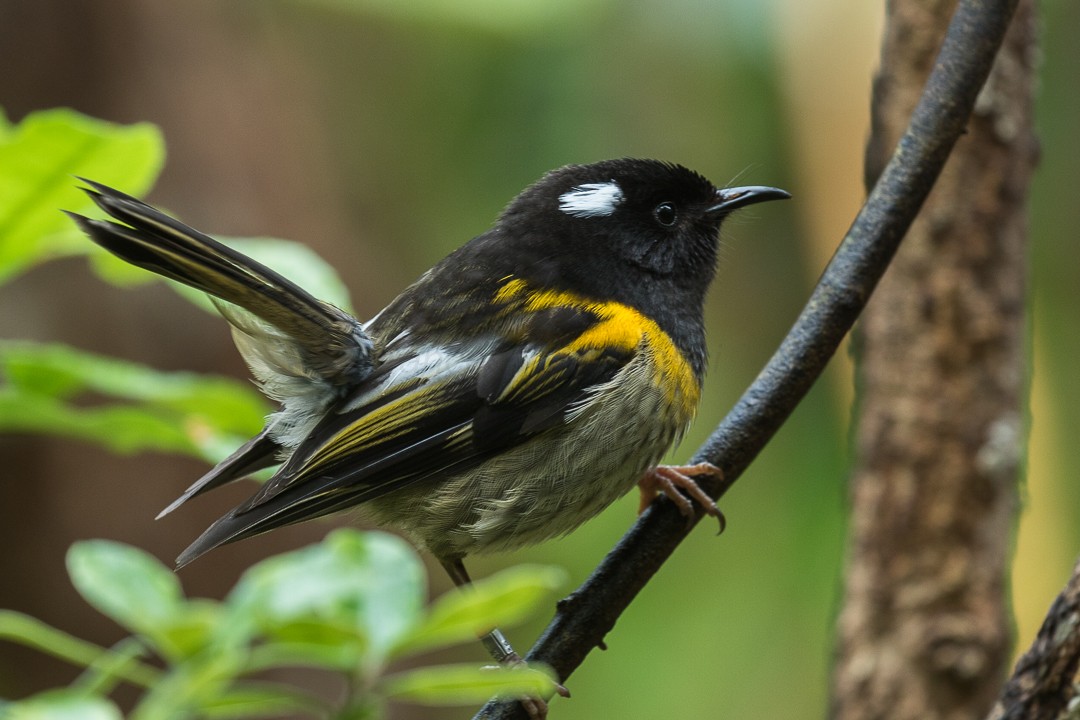Stitchbird
A species of Stitchbirds Scientific name : Notiomystis cincta Genus : Stitchbirds
Stitchbird, A species of Stitchbirds
Botanical name: Notiomystis cincta
Genus: Stitchbirds
Content
Description General Info
 Photo By Francesco Veronesi , used under CC-BY-SA-2.0 /Cropped and compressed from original
Photo By Francesco Veronesi , used under CC-BY-SA-2.0 /Cropped and compressed from original Description
The stitchbird is a small honeyeater-like bird. Males have a dark velvety cap and short white ear-tufts, which can be raised somewhat away from the head. A yellow band across the chest separates the black head from the rest of the body, which is grey. Females and juveniles are duller than males, lacking the black head and yellow chest band. The bill is rather thin and somewhat curved, and the tongue is long with a brush at the end for collecting nectar. Thin whiskers project out and slightly forward from the base of the bill. Stitchbirds are very active and call frequently. Their most common call, a tzit tzit sound, is believed to be the source of their common name, as Buller noted that it "has a fanciful resemblance to the word stitch". They also have a high-pitched whistle and an alarm call which is a nasal pek like a bellbird. Males give a piercing three-note whistle (often heard in spring) and a variety of other calls not given by the female. 
Size
18 cm
Colors
Brown
Black
Yellow
Gray
White
Nest Placement
Tree
Feeding Habits
Stitchbird primarily consumes nectar, including from native plants like haekaro and rata. It also eats over thirty fruit types, favoring Coprosma and five finger, and supplements with small insects. Stitchbird showcases varied foraging adaptations to diverse food sources.
Habitat
The stitchbird favors dense, mature native forests with broadleaf evergreen vegetation, across various altitudes. These birds prefer moist hardwood valleys and lower ridges, particularly those rich in tawa and northern rata. They are also found in forests with towai at higher elevations and might occupy regenerating, wet ridge, and coastal pohutukawa forests, though these are less typical habitats.
Dite type
Nectivorous
General Info
Feeding Habits
Bird food type
Behavior
Research has suggested that they face interspecific competition from the tui and New Zealand bellbird, and will feed from lower-quality food sources when these species are present. The stitchbird rarely lands on the ground and seldom visits flowers on the large canopy trees favoured by the tui and bellbird (this may simply be because of the competition from the more aggressive, larger birds). Their main food is nectar, but the stitchbird's diet covers over twenty species of native flowers and thirty species of fruit and many species of introduced plants. Important natural nectar sources are haekaro, matata, puriri, rata and toropapa. Preferred fruits include Coprosma species, five finger, pate, tree fuchsia and raukawa. The stitchbird also supplements its diet with small insects. 
Species Status
The stitchbird was relatively common early in the European colonisation of New Zealand, and began to decline relatively quickly afterwards, being extinct on the mainland and many offshore islands by 1885. The last sighting on the mainland was in the Tararua Range in the 1880s. The exact cause of the decline is unknown, but is thought to be pressure from introduced species, especially black rats, and introduced avian diseases. Only a small population on Little Barrier Island survived. Starting in the 1980s the New Zealand Wildlife Service (now Department of Conservation) translocated numbers of individuals from Hauturu to other island sanctuaries to create separate populations. These islands were part of New Zealand's network of offshore reserves which have been cleared of introduced species and which protect other rare species including the kakapo and takahe. The world population is unknown; estimates for the size of the remnant population on Hauturu (Little Barrier Island) range from 600 and 6000 adult birds. There are also translocated populations on Tiritiri Matangi Island, Kapiti Island, Zealandia, Maungatautari, Bushy Park and Lake Rotokare. Attempts to establish populations on Hen Island, Cuvier Island and Mokoia Island and the Waitākere Ranges failed. There is also a captive population at Mount Bruce. The Tiritiri Matangi population is growing slowly but more than half the chicks that hatch there die of starvation due to the lack of mature forest, most of the island having been revegetated only since 1984–1994. Only the Little Barrier Island population is thought to be stable as of 2007. This species is classified as Vulnerable (D2) by the IUCN because of its very small range and population. 
Scientific Classification
Phylum
Chordates Class
Birds Order
Perching birds Family
Stitchbird Genus
Stitchbirds Species
Stitchbird